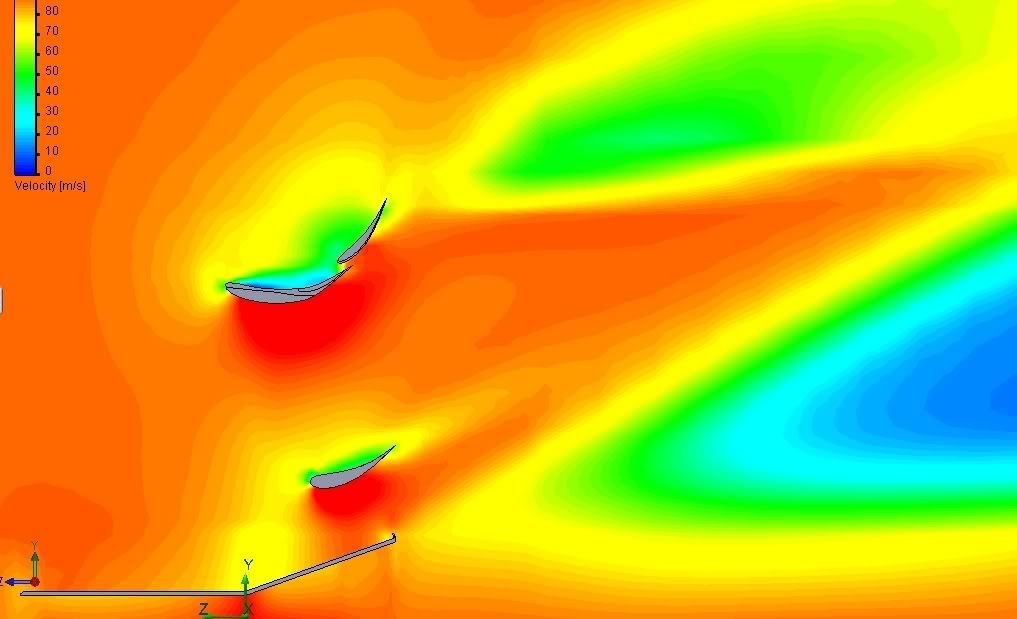- Login or Register
No account yet? Sign up
Good work ringo. It's interesting to see the flow in 3D. L/D ratio still seems really low, though, considering slimjim got somewhere in the range of 10-20 with his model.ringo wrote:low is attached to the sides more than the centre of the wing. Upper element's flow is attached throughout because of the slot. Much better improvement than my first attempt which was just a 2D wing which doesn't tell the whole story.
Lift to drag ratio is 1.834 with down-force of 136 lb. on the wing alone
the last one i did was 0.7 L/D.
Slimjim's excellent model was 2D though.horse wrote:Good work ringo. It's interesting to see the flow in 3D. L/D ratio still seems really low, though, considering slimjim got somewhere in the range of 10-20 with his model.ringo wrote:low is attached to the sides more than the centre of the wing. Upper element's flow is attached throughout because of the slot. Much better improvement than my first attempt which was just a 2D wing which doesn't tell the whole story.
Lift to drag ratio is 1.834 with down-force of 136 lb. on the wing alone
the last one i did was 0.7 L/D.
Is the flow from the diffuser getting anywhere near to reacting with the rear wing?
EDIT:Just_a_fan wrote:The big end plates help by reducing vortices but not to the extent that the rear wing would have a L/D of 20 it seems to me.

That is what happens with very thick profiles. They have very high lift coefficients. Secondly blowing a jet a 3 times or 2 times the speed behind would enhance it as well.horse wrote:Good work ringo. It's interesting to see the flow in 3D. L/D ratio still seems really low, though, considering slimjim got somewhere in the range of 10-20 with his model.ringo wrote:low is attached to the sides more than the centre of the wing. Upper element's flow is attached throughout because of the slot. Much better improvement than my first attempt which was just a 2D wing which doesn't tell the whole story.
Lift to drag ratio is 1.834 with down-force of 136 lb. on the wing alone
the last one i did was 0.7 L/D.
Is the flow from the diffuser getting anywhere near to reacting with the rear wing?
This is 90m/s ~200 mph, I will bring it down to some of the cornering speeds on some tracks and try to find a speed where the element just about stalls.autogyro wrote:Nice work ringo.
What is the range of vehicle speeds you are using?
Figure 5 showed some sort of multielement wing. Looked like there might be 4 in total. It looked to me as if L/D ratio was 2 ish for wings without side fins and 3 for wings with side fins.ringo wrote:L/D of 5 and 3 were with 3 elements right?
'Low Speed Aerodynamics'? Are you a fan of panel methods as well, Ringo?ringo wrote:I have that book.
I suppose that's the goal we are aiming for.ringo wrote:Secondly blowing a jet a 3 times or 2 times the speed behind would enhance it as well.
Scarbs wrote: The rumours suggest the drivers left braking leg, which sits unused on long straights could be used to alter the flow from the snorkel to the rear wing duct, where a valve alters flow through the blown slot to stall the rear wing. This would reduce downforce and also drag, which would allow a higher top speed. Then the driver moves his leg to start to brake for the next turn the valve switches airflow back to normal, the wings airflow reattaches and provides the downforce needed for the turns. This sounds both feasible and far-fetched at the same time.
Interesting quote. You forgot to post the first bit where he says that the rumour is from the internet. Which means places like this. And Scarbs is on here too.SLC wrote:I haven't posted because I couldn't really be bothered to argue with you lot.
Anyway, read this and weep!
http://scarbsf1.wordpress.com/2010/02/2 ... el-rumour/
Scarbs wrote: The rumours suggest the drivers left braking leg, which sits unused on long straights could be used to alter the flow from the snorkel to the rear wing duct, where a valve alters flow through the blown slot to stall the rear wing. This would reduce downforce and also drag, which would allow a higher top speed. Then the driver moves his leg to start to brake for the next turn the valve switches airflow back to normal, the wings airflow reattaches and provides the downforce needed for the turns. This sounds both feasible and far-fetched at the same time.
Not asking you to argue, please contribute! Do you think a stall can work and if so, how is it done and how do you avoid the negative side effects?SLC wrote:I haven't posted because I couldn't really be bothered to argue with you lot.